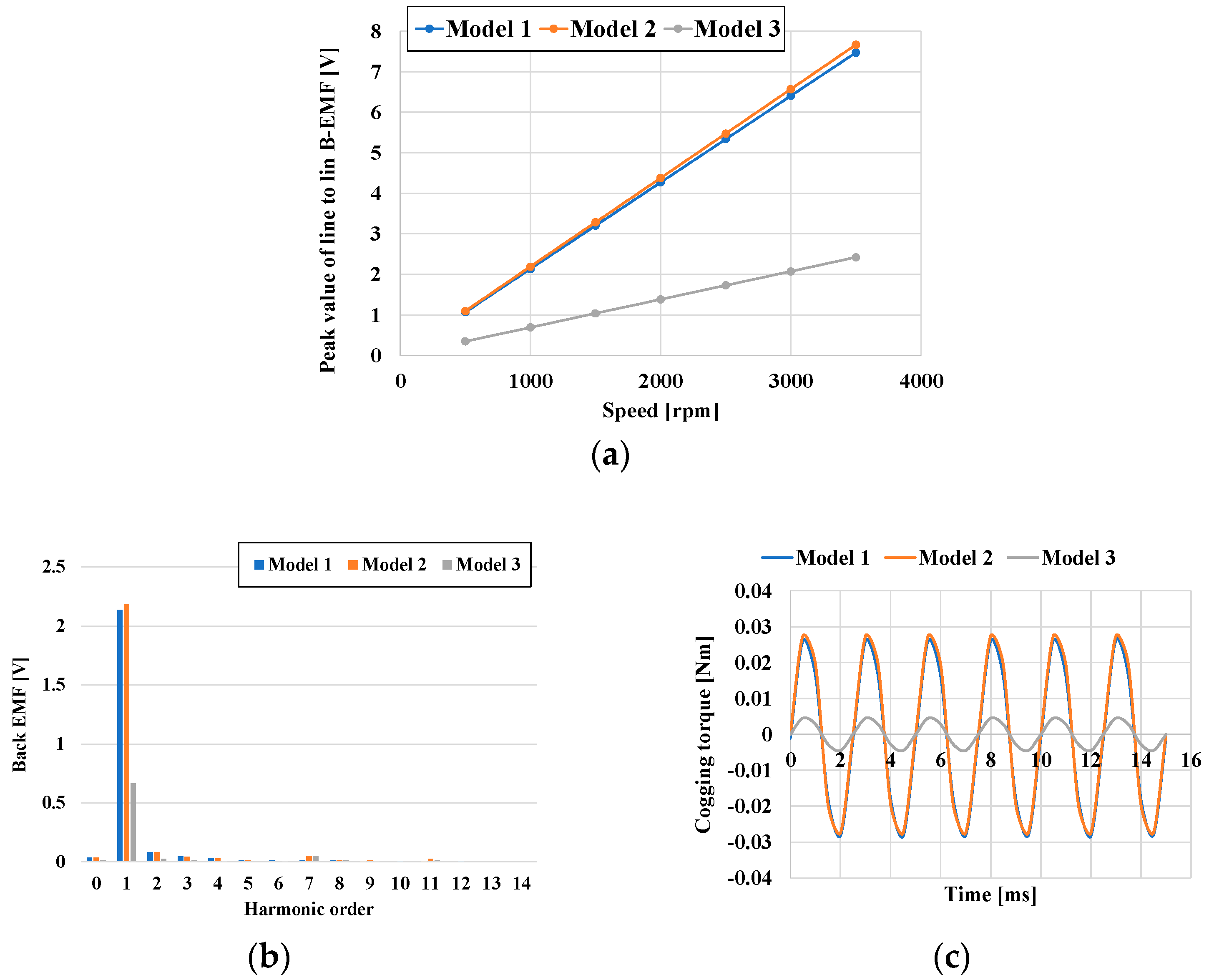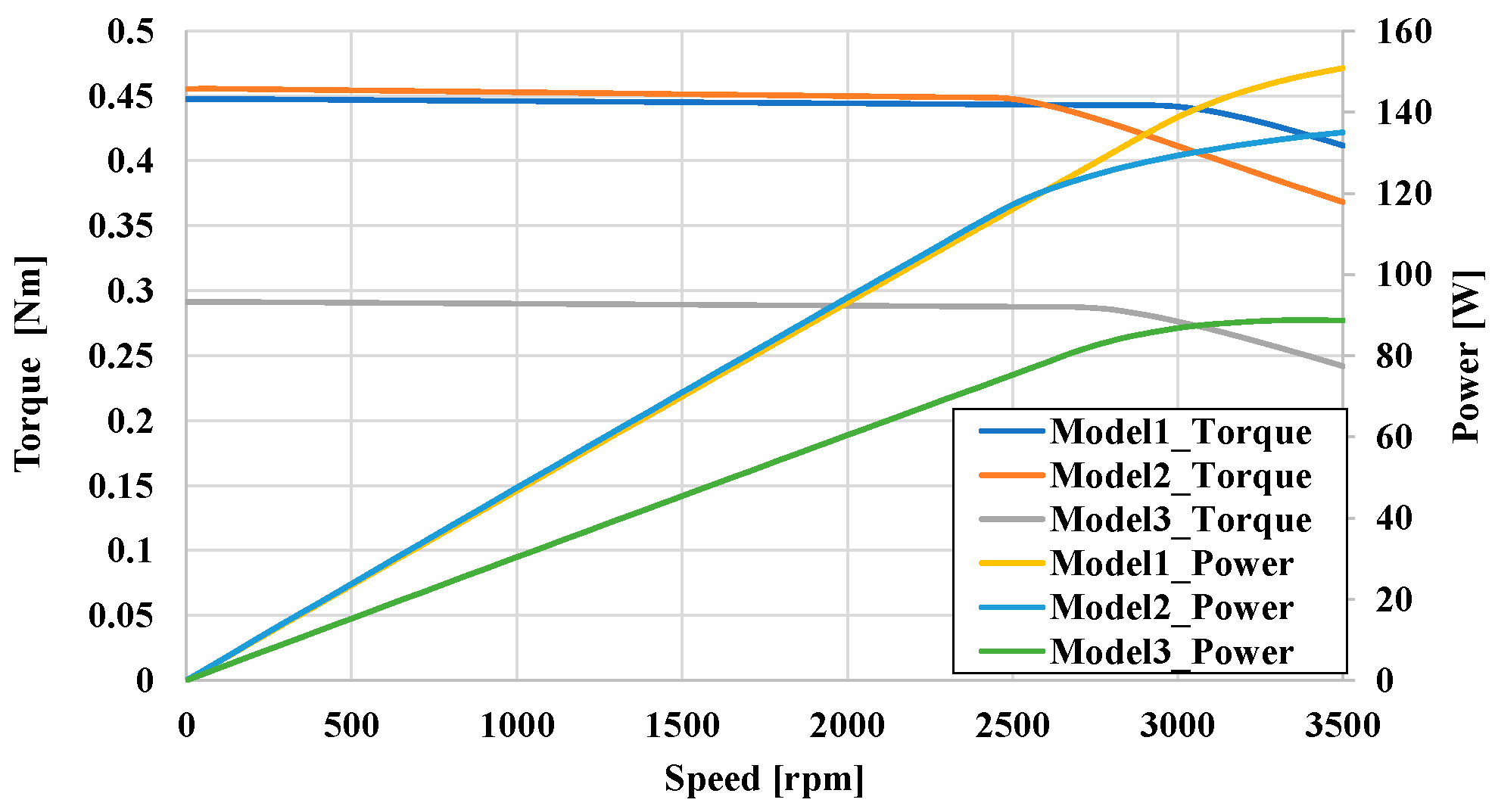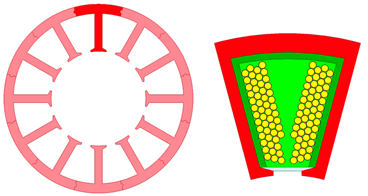Design, Analysis, and Comparison of Electric Vehicle Electric Oil Pump Motor Rotors Using Ferrite Magnet
Abstract
1. Introduction
2. Electrometric Performances
2.1. Winding Factor
2.2. Stator Model for Analyzing Rotor Properties
2.3. Analysis Models of Motor Rotor
3. Comparison of Electromagnetic Performance
3.1. No-Load Analysis of Three Models
3.2. Speed–Torque and Speed–Efficiency Analysis
3.3. A Comparison of the Efficiency Maps and WLTP Class 3 Driving Cycle
4. Results of Experiment
5. Conclusions
- (1)
- The air gap magnetic density of the ferrite magnet rotor motor is very low. Therefore, when designing such a motor, it is necessary to select a design with the maximum air gap magnetic density, minimize magnetic leakage as much as possible, and concentrate the magnetic density of the magnets. Therefore, rotor structures similar to the SPM and spoke-type IPM can meet the design requirements.
- (2)
- The IPM structure is very unsuitable for ferrite rotors, as its construction cannot maximize the magnet area, the magnets are far from the air gap, and the structure retains ribs and bridges, which will inevitably cause magnetic leakage, thereby reducing the power density and motor efficiency.
- (3)
- When analyzing the system efficiency, it is necessary to consider the efficiency of the EOP motor at high operating points, considering the high cooling oil temperature. The system will require high flow rates and high EOP operating speeds. Therefore, although increasing the air gap magnetic density is particularly important, the magnetic density of the stator core also needs attention. It is necessary to improve the magnetic density of the core to reduce iron loss and enhance the high-speed efficiency of the ferrite motor.
Funding
Data Availability Statement
Conflicts of Interest
References
- Rostek, E.; Babiak, M.; Wróblewski, E. The Influence of Oil Pressure in the Engine Lubrication System on Friction Losses. Procedia Eng. 2017, 192, 771–776. [Google Scholar] [CrossRef]
- Doikin, A.; Habib Zadeh, E.; Campean, F.; Priest, M.; Brown, A.; Sherratt, A. Impact of Duty Cycle on Wear Progression in Variable-displacement Vane Oil Pumps. Procedia Manuf. 2018, 16, 115–122. [Google Scholar] [CrossRef]
- Kim, Y.; Lee, J.; Jo, C.; Kim, Y.; Song, M.; Kim, J.; Kim, H. Development and control of an electric oil pump for transmission-based hybrid electric vehicles. IEEE Trans. Veh. Technol. 2011, 60, 1981–1990. [Google Scholar] [CrossRef]
- Tang, X.; Zhang, D.; Liu, T.; Khajepour, A.; Yu, H.; Wang, H. Research on the energy control of a dual-motor hybrid vehicle during engine start-stop process. Energy 2019, 166, 1181–1193. [Google Scholar] [CrossRef]
- Fletcher, T.; Thring, R.; Watkinson, M. An Energy Management Strategy to concurrently optimise fuel consumption & PEM fuel cell lifetime in a hybrid vehicle. Int. J. Hydrogen Energy 2016, 41, 21503–21515. [Google Scholar]
- Choi, C.; Kim, J. Model-Based Angular Position Sensor less Drives of Main Electric Oil Pumps for e-Axles in HEV and BEV. Energies 2024, 17, 4962. [Google Scholar] [CrossRef]
- Huang, J.; Naini, S.S.; Miller, R.; Rizzo, D.; Sebeck, K.; Shurin, S.; Wagner, J. A Hybrid Electric Vehicle Motor Cooling System—Design, Model, and Control. IEEE Trans. Veh. Technol. 2019, 68, 4467–4478. [Google Scholar] [CrossRef]
- Ghahfarokhi, P.S.; Podgornovs, A.; Kallaste, A.; Cardoso, A.J.M.; Belahcen, A.; Vaimann, T. The oil spray cooling system of automotive traction motors: The state of the art. IEEE Trans. Transp. Electrif. 2023, 9, 428–451. [Google Scholar] [CrossRef]
- Huynh, T.A.; Hsieh, M.-F. Improvement of Traction Motor Performance for Electric Vehicles Using Conductors with Insulation of High Thermal Conductivity Considering Cooling Methods. IEEE Trans. Magn. 2021, 57, 8202405. [Google Scholar] [CrossRef]
- Guo, S.; Su, X.D.; Zhao, H. Optimal Design of an Interior Permanent Magnet Synchronous Motor for Electric Vehicle Applications Using a Machine Learning-Based Surrogate Model. Energies 2024, 17, 3864. [Google Scholar] [CrossRef]
- Liu, H.-C.; Kim, I.-G.; Oh, Y.J.; Lee, J.; Go, S.-C. Design of permanent magnet-assisted synchronous reluctance motor for maximized Back-EMF and torque ripple reduction. IEEE Trans. Magn. 2017, 53, 1–4. [Google Scholar] [CrossRef]
- Sone, K.; Takemoto, M.; Ogasawara, S.; Takezaki, K.; Akiy, H. A ferrite PM In-Wheel motor without rare earth materials for electric city commuters. IEEE Trans. Magn. 2012, 48, 2961–2964. [Google Scholar] [CrossRef]
- Obata, M.; Morimoto, S.; Sanada, M.; Inoue, Y. Performance of PMASynRM with ferrite magnets for EV/HEV applications considering productivity. IEEE Trans. Ind. Appl. 2014, 50, 2427–2435. [Google Scholar] [CrossRef]
- Liu, H.C.; Lee, J. Optimum Design of an IE4 Line-Start Synchronous Reluctance Motor Considering Manufacturing Process Loss Effect. IEEE Trans. Ind. Electron. 2018, 65, 3104–3114. [Google Scholar] [CrossRef]
- Wang, Y.; Bianchi, N.; Qu, R. Comparative study of non-rare-earth and rare-earth PM motors for EV applications. Energies 2022, 15, 2711. [Google Scholar] [CrossRef]
- Park, J.-H.; Jung, K.-T.; Jung, Y.-H.; Lim, M.-S.; Yoon, M.-H.; Hong, J.-P.; Jung, J.-W. Design and Verification for the Torque Improvement of a Concentrated Flux-Type Synchronous Motor for Automotive Applications. IEEE Trans. Ind. Appl. 2019, 55, 3534–3543. [Google Scholar] [CrossRef]
- Kalluf, F.J.H.; Isfanuti, A.S.; Tutelea, L.N.; Moldovan-Popa, A.; Boldea, I. 1-kW 2000–4500 r/min ferrite PMSM drive: Comprehensive characterization and two sensorless control options. IEEE Trans. Ind. Appl. 2016, 52, 3980–3989. [Google Scholar] [CrossRef]
- Barcaro, M.; Bianchi, N. Interior PM machines using ferrite to replace rare-earth surface PM machines. IEEE Trans. Ind. Appl. 2014, 50, 979–985. [Google Scholar] [CrossRef]
- Jung, Y.; Park, M.; Kim, K.; Chin, J.; Hong, J.; Lim, M. Design of high-speed multilayer IPMSM using ferrite PM for EV traction considering mechanical and electrical characteristics. IEEE Trans. Ind. Appl. 2021, 57, 327–339. [Google Scholar] [CrossRef]
- Hyundai-Transys. [ENG] Hyundai Transys Electric Powertrain Solution. YouTube. 2020. Available online: https://www.youtube.com/watch?v=h1c-ieAuV7c (accessed on 22 October 2020).
- Hwang, S.-W.; Ryu, J.-Y.; Chin, J.-W.; Park, S.-H.; Kim, D.-K.; Lim, M.-S. Coupled Electromagnetic-Thermal Analysis for Predicting Traction Motor Characteristics according to Electric Vehicle Driving Cycle. IEEE Trans. Veh. Technol. 2021, 70, 4262–4272. [Google Scholar] [CrossRef]
- Mahmouditabar, F.; Baker, N.J. Design Optimization of Induction Motors with Different Stator Slot Rotor Bar Combinations Considering Drive Cycle. Energies 2024, 17, 154. [Google Scholar] [CrossRef]
- Liu, H.-C.; Park, J.S.; An, I.H. Design, Analysis, and Comparison of Electric Vehicle Drive Motor Rotors Using Injection-Molded Carbon-Fiber-Reinforced Plastics. World Elec. Veh. J. 2024, 15, 283. [Google Scholar] [CrossRef]
- Muazzam, H.; Ishak, M.K.; Hanif, A.; Bhatti, A.I. Compensating Thermal Derated Torque of IPMSM Centric Electric Vehicles. IEEE Access 2022, 10, 22468–22480. [Google Scholar] [CrossRef]
- Liu, H.-C.; Kim, H.; Jang, H.; Jang, I.-S.; Lee, J. Ferrite PM Optimization of SPM BLDC Motor for Oil-Pump Applications According to Magnetization Direction. IEEE Trans. Appl. Supercond. 2020, 30, 2977615. [Google Scholar] [CrossRef]













| Item | Unit | Value | 8/12 Stator, Slot of Stator |
|---|---|---|---|
| Outer and Inside Diameter | mm | 60, 30 |  |
| Stack Length | mm | 40 | |
| Air Gap | mm | 0.4 | |
| Coil Size (bare) | mm | 0.71 | |
| No. of Turns, Strands | - | 52, 1 | |
| Phase Resistance@20 degC | Ω | 0.076 | |
| Fill Factor | % | 43 | |
| Bobbin Insulation Thickness | mm | 0.7 |
| Item | Unit | Model 1 | Model 2 | Model 3 |
|---|---|---|---|---|
| No. of Magnet Poles | - | 8 | ||
| PM Grade | NMF-12E | |||
| Outer and Inside Diameter | mm | 28.6, 9, sleeve (0.3) | 29.2, 11 | 29.2, 9 |
| Stack Length | mm | 40 | ||
| Magnet Thickness | mm | 4.5 | ||
| Magnet Weight | g | 58.0 | 51.8 | 46.3 |
| Item | Unit | Model 1 | Model 2 | ||
|---|---|---|---|---|---|
| 25 °C | 65 °C | 25 °C | 65 °C | ||
| WLTP low-range loss | Wh | 0.798 | 0.924 | 0.808 | 0.983 |
| WLTP medium-range loss | 0.529 | 0.602 | 0.536 | 0.639 | |
| WLTP high-range loss | 0.622 | 0.717 | 0.635 | 0.766 | |
| WLTP extra-high-range loss | 0.589 | 0.754 | 0.618 | 0.800 | |
| Item | FEM | Experiment | Error |
|---|---|---|---|
| Base speed | 3200 rpm | 3194 rpm | 0.18% |
| Torque | 0.348 Nm | 0.359 Nm | 3.0% |
| Power | 116.5 W | 120.3 W | 3.5% |
| Efficiency | 80.2% | 80.0% | 0.2% |
Disclaimer/Publisher’s Note: The statements, opinions and data contained in all publications are solely those of the individual author(s) and contributor(s) and not of MDPI and/or the editor(s). MDPI and/or the editor(s) disclaim responsibility for any injury to people or property resulting from any ideas, methods, instructions or products referred to in the content. |
© 2025 by the author. Published by MDPI on behalf of the World Electric Vehicle Association. Licensee MDPI, Basel, Switzerland. This article is an open access article distributed under the terms and conditions of the Creative Commons Attribution (CC BY) license (https://creativecommons.org/licenses/by/4.0/).
Share and Cite
Liu, H.-C. Design, Analysis, and Comparison of Electric Vehicle Electric Oil Pump Motor Rotors Using Ferrite Magnet. World Electr. Veh. J. 2025, 16, 50. https://doi.org/10.3390/wevj16010050
Liu H-C. Design, Analysis, and Comparison of Electric Vehicle Electric Oil Pump Motor Rotors Using Ferrite Magnet. World Electric Vehicle Journal. 2025; 16(1):50. https://doi.org/10.3390/wevj16010050
Chicago/Turabian StyleLiu, Huai-Cong. 2025. "Design, Analysis, and Comparison of Electric Vehicle Electric Oil Pump Motor Rotors Using Ferrite Magnet" World Electric Vehicle Journal 16, no. 1: 50. https://doi.org/10.3390/wevj16010050
APA StyleLiu, H.-C. (2025). Design, Analysis, and Comparison of Electric Vehicle Electric Oil Pump Motor Rotors Using Ferrite Magnet. World Electric Vehicle Journal, 16(1), 50. https://doi.org/10.3390/wevj16010050







